Lime believes in sharing knowledge. Here in the Masterclass we will give you professional decorating advice and step by step guides through some of our most popular projects.
- Exterior Restoration
- Cracked Plaster
- Door Restoration
- Timber Repairs
- Choosing Paint Colour and Finish
- Resolving Ceiling Problems
Project: Restoration of 16th century oak framed cottage in Warwickshire.
The cause of the problem.
The cottage had a modern, textured exterior finish. The previous lack of preparation and the use of an unsuitable product combined with the natural movement of a timber framed building had resulted in its poor condition. The coating had lost adhesion therefore absorbing and trapping moisture underneath. Consequently further damage had taken place to the brickwork and timber structure.

Thorough preparation by Lime involved total removal of the previous coating, replacement of damaged bricks and timber and repointing work. Once completed we could then proceed with the exterior decoration. Three coats of breathable, white masonry paint were applied directly to the brickwork. This was followed by three coats of ebony wood stain to the timer frame and finally black gloss to the metal window frames.

The final result is a fully restored cottage brought back to its original beauty. The new finish will serve to protect and preserve the fabric of the building for years to come with minimum maintenance.

Project: Restoring Severely Cracked Plaster
This was the ceiling of a Victorian period property. The finish was the original lath and plaster, but over time the age and natural movement of the building had resulted in the ceiling sagging in places and becoming severly cracked.

Whilst many would choose to re-plaster, Lime always aims to restore beautiful features to their original condition.
Initially a "V" groove was made in the cracks to enable the filler to go beyond the surface of the crack and gain full adhesion. The first fill was with a specialist crack treatment filler Toupret Elafib and this was left for 24 hours. Toupret Elafib has a long lasting flexibility and allows for slight movements in plaster. This process was repeated three times due to the expected natural shrinkage of the filler as it dries. On this occasion it was not necessary to first bridge the cracks with fine scrim tape, which is sometimes used to bridge larger cracks or for strengthening joints in plasterboard.

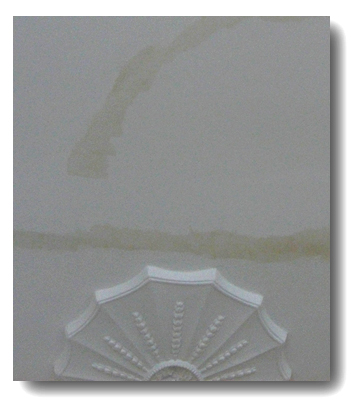 In order to create an appropriate paintable surface, the final fill was with Toupret interior powder filler and the surface was then fine sanded until smooth. The filler used is flexible and will absorb future vibrations of movement.
In order to create an appropriate paintable surface, the final fill was with Toupret interior powder filler and the surface was then fine sanded until smooth. The filler used is flexible and will absorb future vibrations of movement.
Finally the ceiling was painted with 3 coats of flat matt emulsion and the cracks are no longer visible. The end result is a fully restored ornate Victorian ceiling.

Project: Restoring original doors
 If your exterior doors seem to be beyond repair, this may not actually be the case. Lime has many years of experience with restoring, often irreplacable, period doors. This enables a property to retain its original appearance and integrity.
If your exterior doors seem to be beyond repair, this may not actually be the case. Lime has many years of experience with restoring, often irreplacable, period doors. This enables a property to retain its original appearance and integrity.
This door belongs to a Victorian property in Leicester and has had many badly applied coatings over the years. Lime mechanically sanded it back to a sound surface. Open joins were filled with a flexible filler to avoid re-opening in the future.
 Primer undercoat was then applied and any surface defects filled will a fine surface filler. A further coat of primer undercoat was then applied. The door was then sanded with a fine grade sandpaper ready for the final coat.
Primer undercoat was then applied and any surface defects filled will a fine surface filler. A further coat of primer undercoat was then applied. The door was then sanded with a fine grade sandpaper ready for the final coat.
The choice of the final two top coatings produced the mirrored gloss finish. It will have a maintenance cycle of 8-10 years.

Lime restored the door of a 15th century cottage in Leicestershire.
The same repairs and preparation were carried out as detailed.
The final look was achieved by two coats of an eggshell finish and new door furniture. This door has a maintenance cycle of 5 years.
Timber Repairs



If you think your exterior or interior woodwork is beyond repair, this may not necessarily be the case. Lime can offer a permanent, strong and durable repair solution which preserves the original timber allowing the authentic features and character to remain.
It is ideal in conservation areas for sash windows, ledge and brace doors, wooden windows , window frames, window sills, interior/ exterior doors and frames. This solution is part of our pre-paint repairs service and will return woodwork back to an as new condition, outlasting conventional repair methods.
Project: Repairs to old Oak Window Frame
This oak window frame belonging to a 15th Century cottage in Leicestershire was severely rotted. The cost for the replacement of this frame would have been £2750.
Lime removed the rotten timber ready for the recommended resin repair:

Once the rotten timber had been removed, infill timbers along with a 2-part resin were then used to mould the frame back to its original shape. Once cured, the window frame was then sanded both by hand and mechanical means with various grades of abrasives. This window then needed new putties to most glazing bars

Various coatings were applied to match the finish of the windows in the cottage. The end result is an undetectable repair which will not shrink or crack. The repair benefits from the resin manufacturers guarantee.
This kind of repair can be used on any window frames, doors, door frames, facias, soffits as well as interior woodwork problems.

A guide to choosing paint colour and manufacturers


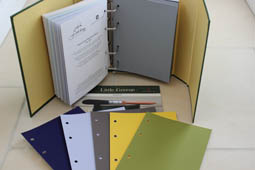
Choosing paint colours for your decorating project can prove to be quite a challenge. Today there are so many different paints to choose from produced by different manufacturers that it can be difficult to know where to start.
The use of colour can dramatically transform our perception of space as well as changing the feel or mood of a room. Natural colours inspired by nature can be used to create a peaceful, calm quality. Period or classic colours can create an elegant, traditional feel. Bold, bright or complimentary colours are often used on accent walls or in rooms to create a striking statement.
Lime Decorators can supply paint from all leading professional and trade manufacturers. We always carry a wide selection of colour cards, complete fan decks and larger professional colour albums. These larger samples are more helpful when making colour choices as the appearance of a hue may vary as natural light changes throughout the day. The appearance will also change under the type and colour temperature of any artificial lighting.
Our most requested and highly recommended paints are listed below:
Little Greene Paint offers a wide range of contemporary and classic colours. These include historic Georgian, Regency, Victorian, 30's and 50's period colours authenticated by English Heritage. They also recreate retrospective colours from the 60's and 70's as well as a harmonious neutral colour scale palette. Their paint offers an unrivalled depth of colour.
Why not download their latest brochure?

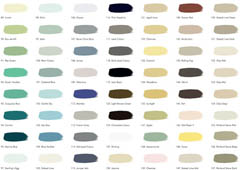
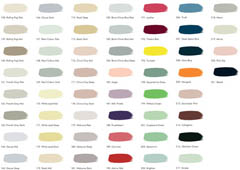
Farrow & Ball offers a popular range of distinctive colours. They have a palette of 132 beautiful colours with iconic names.
Sikkens offers fantastic colour choices and a range of premium products for internal and external woodwork.
Lime also recommends Sanderson, Paint Library, Fired Earth and other paint products featured on our links page.
As part of our service, Lime offers free advice on paint colours and finishes as well as providing colour cards and sample pots to help to inspire your colour choices.
A guide to choosing the correct type of paints
Due to recent advances in paint technology following EU environment legislation ( EU directive 2004/42/EC ) to reduce volatile organic compounds (VOC's) in paint, many people are confused about what paint is suitable for their decorating needs.
Older solvent based paints are now being replaced by water based paints. These paints are better for the environment and have no adverse effects on human health as they are very low or free from all toxic chemicals and are odour free. Also, this paint will not yellow over time. Importantly, because they are water based paints, brushes and rollers can be rinsed clean with just water alone.
Oil based paints are often chosen where a tough, durable finish is required. Brushes and rollers will need to be cleaned with turpentine or white spirit. However, the new water based formula paints are high performing and can be used on all types of interior and exterior surfaces giving the same quality, durable finish as expected with oil based.
A guide to paint finishes
Matt (emulsion). Usually selected for walls and ceilings, it provides a matt (flat and non-reflective) effect and is often used to cover large areas. It is easier to apply than other paints and can be re-applied without too much preparation.
Satin (emulsion). This gives a low to mid sheen providing a chic, sophisticated finish. Satin is commonly used in hallways and in darker areas to maximise light.
Some paints are referred to as vinyl matt and vinyl silk emulsion. They contain vinyl resins but have less acrylic content and less natural pigment. If using vinyl paints always ensure walls are completely dry as they are non breathable and moisture may be trapped in the wall.
Lime recommends high quality emulsions that do not contain vinyl resins. Vinyl free paints are more breathable and, as they contain more pigments, produce a greater depth of colour with a solid looking finish.
Eggshell. A mid level sheen with a classic, soft, subtle finish. Eggshell is a more durable paint and provides a washable surface. This makes it a good choice for kitchens and bathrooms as it is more resistant to water and grease. It is also often selected for children's rooms, high traffic areas and interior woodwork.
Gloss. This paint provides a high sheen finish and it is completely washable and very hard wearing. Gloss is therefore suitable for interior and exterior woodwork that needs to be cleaned regularly.
Masonry Paint. Exterior masonry paint comes in a variety of finishes ranging from ultra smooth to highly textured. The high texture can be used to disguise fine surface cracks. It can also be used on brick, stone or rendered walls. Always choose a high quality, flexible, durable paint with breathability. This allows moisture out but prevents water penetrating from the outside.


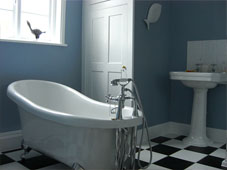
For further information please feel free to ask questions via twitter or see Lime Links for our recommended paints.
Project: Resolving Cosmetic Ceiling Problems
Lime is frequently involved in the repair and redecoration of problematic ceilings. Many clients believe that the only solution is to remove the problem ceiling and then employ a plasterer to re-board and skim. However, depending on the specific problem, there are often various solutions. A skilled painter and decorator should be able to offer you professional advice before carrying out any work. Some of the most frequent ceiling problems that Lime encounters are described below.
The Problems, Causes and Solutions:


Minor / Random Cracks
Causes: movement, settlement, shrinkage.
Solutions: Minor cracks can be easily repaired. Rake out, make good with a suitable filler, sand and re-paint the repaired surface.
Major Cracks / Defective Plasterwork
Causes: age, moisture, physical or structural damage.
Solutions: Any possible underlying structural problems should always be investigated and resolved before repairs are carried out. All areas of defective plasterwork removed and cracks raked out. Damage repaired using a suitable flexible filler or re-plastered depending on size and severity. Sand and re-paint. For further information please view the Lime masterclass on severely cracked plaster.
Loose / Flaking Artex


Causes: moisture, poor adhesive coatings, poor surface preparation.
Solutions: Remove all loose surface by thorough scraping or brushing. Seal the bare ceiling, re-artex and paint. Alternatively all artex could be removed and the ceiling filled, painted or papered.
Sagging / Uneven Appearance / Parallel Cracks
Causes: age, lath and plaster, weight above, weakened, stressed or poorly secured ceiling joists or plasterboards.
Solutions: Repair weakened areas. Apply self adhesive scrim tape to plasterboard joints, fill, sand and re-paint. If the ceiling damage is caused by plaster coming away from laths in older properties then the best solution is usually papering (see below) or removal and plaster boarding. However, uneven ceilings in older/period properties can often be left and considered to be part of the building's character.
Stains / Mould
Causes: damp, humid conditions, leaking pipes
Solutions: Any possible underlying causes should be addressed before any redecorating takes place. Scrape or brush away any mould or stains and treat with either a fungicidal solution or an effective stain blocking primer. Allow to dry before repainting.
Should I paper a ceiling?
There are many good reasons for choosing to paper a ceiling instead of painting it. It may be chosen as an option when painting alone cannot address the issues. It may also be considered as a cost effective measure if re-artexing or replastering is suggested.
However papering ceilings is becoming increasingly popular as a way of restoring original features or giving a richer feel to a period property. It is also being used in modern homes as a design idea in its own right.




